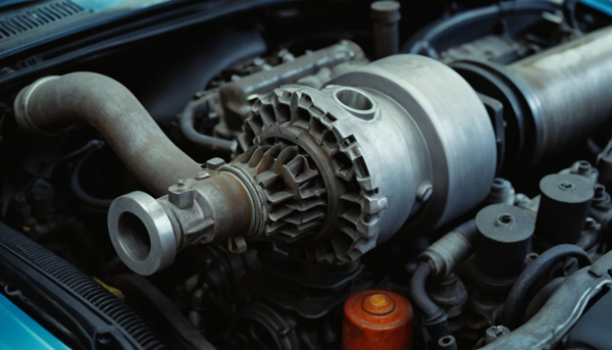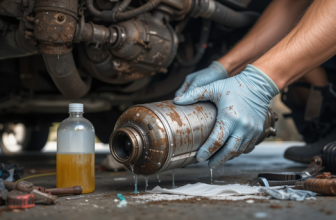What does a bad EGR valve do? Discover symptoms, risks & easy fixes to avoid engine damage.
What Does a Bad EGR Valve Do? 🛠️ Shocking Engine Damage Signs to Watch Out For
Ever noticed your car hesitating or idling rough? 🚗 You might wonder, “Is my engine acting up?” It could be your EGR valve, causing trouble under the hood. This small part is key to your car’s performance. When it fails, you’ll notice.
We’ll explore what a bad EGR valve does, its impact on your car, and how to fix it. We’ll do it before it costs you a lot.
🚦 What Is an EGR Valve Anyways?
The Exhaust Gas Recirculation (EGR) valve is small but important. It sends some exhaust gases back into your engine. This helps cut down on harmful emissions and makes your car more fuel-efficient.
Here’s how it works simply:
- It opens at certain speeds and engine temperatures.
- It mixes exhaust gases with incoming air.
- This lowers the engine’s combustion temperature.
- This leads to cleaner emissions and better performance.
But if it fails, your engine’s system can get out of balance.
⚠️ What Does a Bad EGR Valve Do?
A faulty EGR valve messes with your engine’s airflow, causing big problems. It might get stuck open or closed, leading to different issues.
If It’s Stuck Open:
- Too much exhaust enters the engine.
- Engine runs rough.
- Fuel burns poorly.
- Car stalls or hesitates.
If It’s Stuck Closed:
- No exhaust gets recycled.
- Higher combustion temps.
- More emissions.
- Engine knocks or pings.
Either way, it’s bad for your engine and your wallet.
🔍 Common Symptoms of a Bad EGR Valve
Think your EGR valve might be failing? Look for these signs:
- Rough idling
- Poor acceleration
- Check engine light on
- Failed emissions test
- Strong fuel smell
- Knocking or pinging noise
- Lower gas mileage
These symptoms come on slowly. Don’t ignore them—your engine is trying to tell you something!
🧠 Why the EGR Valve Fails
It’s not always your driving. Sometimes, it’s buildup or age.
Here’s what causes EGR valves to fail:
- Carbon deposits clog the valve.
- Electrical or vacuum system failure.
- Faulty temperature or position sensors.
- Worn-out valve spring.
- Poor-quality fuel.
👉 Most EGR valves last 50,000–70,000 miles, but it varies.
📊 EGR Valve Problem vs. Other Engine Issues
| Symptom | Bad EGR Valve | Bad Spark Plug | Dirty Air Filter |
|---|---|---|---|
| Rough Idling | ✅ Yes | ✅ Yes | ❌ Rare |
| Loss of Power | ✅ Yes | ✅ Yes | ✅ Yes |
| Check Engine Light | ✅ Yes | ✅ Yes | ✅ Yes |
| Emissions Test Failure | ✅ Yes | ❌ No | ❌ No |
| Fuel Smell | ✅ Yes | ❌ No | ❌ No |
As you can see, EGR valve symptoms often overlap. This makes it hard to figure out without the right tests.
🔧 How to Diagnose a Faulty EGR Valve
You don’t need to be a mechanic to spot the problem. But, getting a proper diagnosis is key.
Steps to check if your EGR valve is bad:
- Scan the engine codes with an OBD-II reader.
- Physically inspect the valve for carbon buildup.
- Check if the valve moves when engine revs.
- Use a vacuum gauge or multimeter to test functionality (based on valve type).
- Spray carb cleaner and look for RPM changes (classic trick!).
🧪 If you’re unsure, a mechanic can test it in under 30 minutes.
💸 How Much Does It Cost to Replace an EGR Valve?
The cost varies based on your car’s make and model. Here’s a quick guide:
| Repair Type | Cost Range |
|---|---|
| EGR Valve Replacement | $150–$500 |
| Labor (1–2 hours) | $70–$200 |
| Total Estimated Cost | $220–$700 |
You can DIY it if you’re handy, saving on labor. But, if you’re not skilled, it’s safer to let a pro do it.
🧼 Can You Clean a Bad EGR Valve Instead?
Yes! Cleaning the valve can sometimes fix it. But, cleaning is usually just a temporary fix.
Cleaning steps:
- Remove the valve carefully.
- Spray with carburetor or EGR valve cleaner.
- Scrub gently with a wire brush.
- Let it dry fully before reinstalling.
🧽 Tip: Clean your EGR valve every 30,000 miles to prevent buildup.
🌍 Emissions Impact of a Faulty EGR Valve
A bad valve can cause a big spike in emissions, like nitrogen oxides (NOx). This is bad for:
- Failing smog checks
- Environmental impact
- Legal issues in emissions-regulated states
💡 Fixing your EGR valve helps both your engine and the planet.
⛽ Fuel Economy and EGR Valve Health
A bad EGR valve hurts your MPG. How?
- It messes with air/fuel mix
- Causes incomplete burning
- Engine works harder
Fuel efficiency may drop by 5–15%, depending on the valve’s condition.
Want better mileage? Keep that EGR valve clean and working right.
🧯 Ignoring It? Here’s What Happens…
Think you can drive with a bad EGR valve? Technically, yes—but you shouldn’t. 🚫
Here’s what could happen if you ignore it:
- Long-term engine damage
- Catalytic converter failure
- Failed emissions test
- Decreased resale value
- Risk of engine overheating
Small part, huge consequences.
🛠️ EGR Valve Types (And Why It Matters)
Not all EGR valves are the same. The type matters for diagnosing and fixing.
| EGR Valve Type | Common In | Control Type |
|---|---|---|
| Vacuum-Operated | Older vehicles | Mechanical |
| Electronic EGR | Most 2000+ models | Computer-controlled |
| EGR Solenoid | Trucks/SUVs | On-off flow control |
🧠 Knowing your valve type helps avoid misdiagnosis and saves money.
👂 Strange Noises? It Could Be the Valve
If you hear knocking, pinging, or tapping, your EGR valve might be stuck closed. This causes hotter combustion and detonation noises.
🚨 Don’t ignore these sounds—they’re your engine’s SOS.
🧰 Preventive Tips to Keep Your EGR Valve Healthy
You don’t have to wait until it breaks. Here’s how to prevent problems:
- Use high-quality fuel
- Get regular engine tune-ups
- Clean the valve every 30,000–40,000 miles
- Replace your air filter on schedule
- Don’t ignore check engine lights
A little care now saves big bucks later.
🤔 Is It Safe to Drive with a Bad EGR Valve?
Short trips? Probably fine. Long-term? Risky. Very risky.
You might manage a few errands or a work commute, but constant stress on your engine can add up fast.
The sooner you fix it, the cheaper it’ll be. 💰
✅ Key Takeaways
Let’s recap what a bad EGR valve really means for your vehicle:
- It messes with airflow and causes engine trouble.
- Symptoms include rough idling, power loss, and fuel issues.
- Replacing it early can prevent expensive repairs.
- Cleaning it is often a temporary fix, not a long-term solution.
- Don’t ignore warning signs—it’s not worth the risk.
🎯 Spot it early. Fix it fast. Drive worry-free.
❓FAQs
How do I know if my EGR valve is failing?
Look for rough idling, reduced power, poor MPG, and a check engine light.
Can a bad EGR valve cause starting problems?
Yes, if it’s stuck open. It can mess with combustion at ignition.
Does replacing an EGR valve improve performance?
Absolutely. It fixes air-fuel balance and makes throttle response better.
Is cleaning the EGR valve a long-term solution?
It can help, but if it’s worn out, replacement is better.
What happens if I keep driving with a bad EGR valve?
You risk long-term engine damage, higher emissions, and costly repairs.
🔗 References
https://www.autoblog.com/article/what-is-an-egr-valve/
https://www.enginebuildermag.com/2020/05/egr-valves-function-failures-and-fixes/
https://www.cars.com/articles/what-does-the-egr-valve-do-in-a-car-437858/





